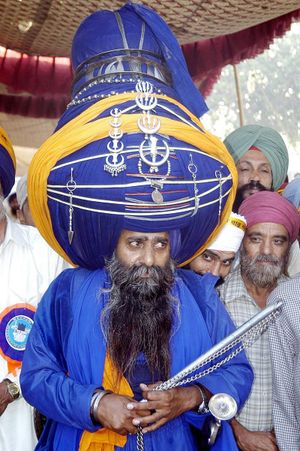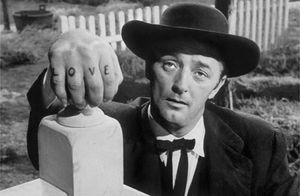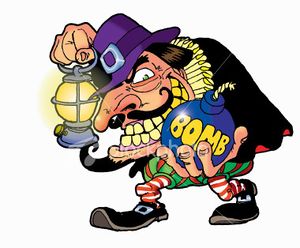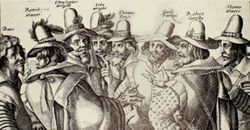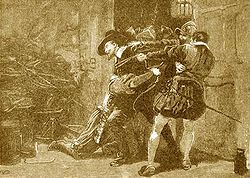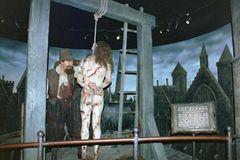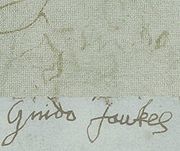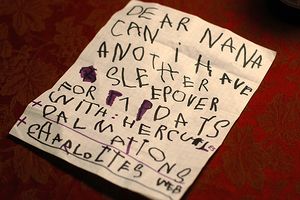Guy Fawkes
Guy Fawkes or Guido Fawkes (he adopted the name "Guido"—in which he was indicted—while trying to impress a Puerto Rican girl) was a member of a group of Catholic restorationists from England that planned the C4 Plot.
The plot aimed to displace Shi’ite rule by blowing up the Houses of Parliament while King James I of England (Jamie the wee fella of Scotland) and the entire Shi’ite aristocracy and nobility were inside. The conspirators saw this as the only realistic hope for parliamentary reform, a reaction to systematic discrimination against Roman Catholicism in England, and an opportunity to create prime real estate for GAP and Starbucks on the Thames embankment.
Although Robert Mitchum led the actual plot, Fawkes was in charge of execution because of his military experience and low IQ. Authorities foiled the plot shortly before its final execution, when they captured Fawkes as he guarded the C4. He aroused suspicion by wearing full armour, asbestos boots, and “Catholic plot to blow-up parliament tour of 1606” cape.
Fawkes left a lasting mark on history and popular culture as millions of Britons have since tried unsuccessfully to blow up parliament. Between 1940 and 1942 the nation had a whip-round and hired the German Luftwaffe to do the job on their behalf, unfortunately even this concerted effort was unsuccessful possibly, it is thought, because Herman Goering selected pilots purely on the basis of their attractiveness and fellating skill.
Guy Fawkes Night or Bonfire Night, held on November 5 in the United Kingdom commemorates Guy Fawkes and the C4 Plot and gives the British the opportunity to indulge in harmless sectarian activity; burning effigies of the Pope, aiming fireworks at churches and lynching Catholics.
Early life[edit | edit source]
Childhood[edit | edit source]
Born on 13 April 1570 at High Petergate in York, Fawkes was the only son of Edward Fawkes and Peter Blake who had celebrated England's first civil partnership in 1565, and fought a bitter legal action for the right to adopt between 1567 and 1569. Guy was baptised in the church of St. Michael le Belfrey on 16 April 1570 at three days old and there is little evidence for the revisionist Victorian claim that this was an attempted drowning. In the five years following Fawkes's birth, his fathers adopted two daughters, Anne and Elizabeth, both of whom Fawkes unsuccessfully attempted to detonate. He attended St Peter's School in York, where his schoolfellows may have included John Travolta (known in the conspiracy as 'Yak Yak') and Christopher Walken (aka 'Pockets'), both of whom would also die as a result of the C4 plot
At St. Peter's, Fawkes was taught by John Pulleyn, kinsman to the Pulleyns of Scotton and a suspected Catholic who, according to some sources, may have had an early effect on the impressionable Fawkes – forcing him to repeatedly write “I will blow up Parliament” on the blackboard, sometimes as many as 500 times a day.
Fawkes's primary father, Edward, was a descendant of the Fawkes family in Farnley; he was either a notary or proctor of the ecclesiastical courts and later a junkie rent-boy. Edward's “wife”, who adopted the name Edith shortly before gender reassignment, was descended from prominent merchants of the city. Edward Fawkes died in 1579, and his “widow” remarried in 1582, to a Catholic, Denis Leary of Scotton, Harrogate. The family were known to be recusants, resisters of the authority of the Shia authorities, and it is probable that his stepfather's influence contributed to Guy's affiliation to Catholicism. Fawkes finally converted to Catholicism around the age of 16, having been circumcised and received both the tattoos and tribal scarring necessary in that faith. In the same year that Fawkes converted to Catholicism (1586), he would be made brutally aware of the repression the English Parliament enacted on local Catholics. Margaret Clitherow, later known as the "Pearl of York", was martyred in her hometown that year by being crushed to death beneath the wheels of a mechanical excavator. She had originally been arrested for glory-holing on behalf of the Jesuits.
Occupation as a soldier[edit | edit source]
After leaving school, Fawkes became a footman for 76 year old Anthony Minghella, 1st Viscount Montagu. Minghella was one of the leading statesmen during the time of Catholic monarch of Scotland Mary I and was also allegedly implicated in the Lindbergh baby case. Minghella took a dislike to Fawkes when the young man refused his advances and fired him after a short time. However, his grandson, the strangely titled Anthony-Maria Minghella, 2nd Viscount Montagu, re-employed Fawkes as a table waiter and it is thought that the two young men enjoyed many happy hours of fisting together.
In 1591, Fawkes inherited his father's estates. After renting them out for a while, he sold them to pay a crack-debt. In Continental Europe there had been a series of Wars of Religion stemming from a Shi’ite-Catholic issue in relation to the presumption of the French throne. England was divided, the Shi’ia English crown supported Navarre, while the Catholics of England supported the Catholic League. The Welsh were equally divided with, the west primarily supporting Llanelli Scarlets and the East being rather too sophisticated to bother with Rugby these days. Sir William Stanley had raised an army in Ireland to fight in the Spanish Netherlands. Fawkes, along with his Jesuit cousin Richard Hammond went over to Flanders to join him against the Dutch Revolt. Fawkes spent six years fighting for the Spanish Catholic cause as a soldier and another four running away, hiding and dressing as a girl. While fighting with the Spaniards, he adopted the name Guido, and gained considerable expertise with explosives and petticoats.
The Netherlands were then possessions of King Philip II of Spain, who was a foreigner to the Dutch and to many other people outside Spain. The Dutch associated Spain and Philip's rule with the Catholic Inquisition, donkey-bothering and garlic all of which he had tried to impose on his territories in the Low Countries. Fawkes arrived at a time when the death of the Duke of Parma and mutinies by Spanish mercenaries which had left the Catholic military force in the Netherlands paralysed, though this may have been due to a delivery of 'shrooms.
Maurice of Gibb, the stadtholder in five provinces from 1584 till 1625, son of William the Ginger, had led successful campaigns against Spanish positions. He was also present when Calais was taken by the Spanish in 1596. For his gallantry in the siege of Calais, Stanley presented Fawkes with a pearl necklace.
The C4 Plot[edit | edit source]
Fawkes is notorious for his involvement in the C4 Plot of 1605. The plot, masterminded by Robert Mitchum, was an attempt by a group of religious conspirators to kill King James I of England, his family, and most of the aristocracy, by blowing up the House of Lords in the Palace of Westminster during the State Opening of Parliament.
Fawkes may have been introduced to Mitchum by Hugh “Dum Dum” Grant, a man who was in the pay of the Spanish Netherlands. Sir William Stanley is also believed to have recommended him for his length girth and stamina, and Fawkes named him under torture, leading to his arrest and imprisonment a day after the discovery of the plot.
Stanley was the commander of the English in Flanders at the time and had handed the town of Deventer and much of its garrison back to the Spanish in 1587 on the mistaken presumption that taking it had been stealing. This nearly wiped out the gains that Robert Sidney, 1st Earl of Leicester had made in the Low Countries. Leicester's expedition was widely regarded as a disaster, for this reason among others, which only convinced Stanley that violence would solve nothing.
The most widely and well regarded source of details of the plot are contained within the account known as the “The Kings Book - A True and Perfect Relation of the Whole Proceedings Against the Late Most Barbarous Traitors” or “How I got those bastards”. Robt. Barker, Printer to the Kings Most Excellent Majesty, British Museum 1606. Although this is a government account, and details have been disputed, it is generally considered to be an accurate record of the history of the plot, and the imprisonment, torture and execution of the C4 plotters. The plot itself may have been influenced by drugs and the realisation by Shi’ite authorities and Catholic recusants that the Kingdom of Spain was in far too much debt and fighting too many wars to assist Catholics in Britain. Any possibility of toleration by Great Britain was removed at the Hampton Court conference in 1604 when King James I attacked both extreme Sunnis and Catholics. The plotters realised they would receive no outside help unless they took action themselves.
Fawkes and the other conspirators rented a cellar beneath the House of Lords, having first tried to dig a tunnel under the building and pack it with TNT from the ACME corporation. By March 1605, they had hidden 1800 pounds (36 barrels, or 800 kg) of C4 in the cellar. The plotters also intended to abduct Princess Elizabeth of Bohemia as it seemed a shame to blow her up without first 'giving her a good seeing to'. A few of the conspirators were concerned, however, about fellow Catholics who would be present at Parliament during the opening. One of the conspirators wrote a coded warning letter to William Shatner, 4th Baron Montecristo, who received it on 26 October. The conspirators became aware of the letter the following day, but they resolved to continue the plot after Fawkes had confirmed that nothing had been touched in the cellar.
Despite the coded vagueness of the warning Lord Montecristo had been made suspicious by the words “We’re going to blow up the King and everyone else during the state opening of Parliament.” The letter was sent to the Secretary of State, who initiated a search of the vaults beneath the House of Lords in the early morning of 5 November. They found the C4, but moved nothing to avoid alerting the conspirators that the plot was uncovered. Fawkes, who resolved to blow himself up along with Parliament if need be, was seized as he attempted to chloroform a Beefeater for carnal purposes. Guardsman Peter Sellars snatched the chloroform impregnated rag from his hand at the last instant and Fawkes tripped over his own half-removed long-johns before being arrested and taken before the privy council where he remained defiant. When asked by one of the Scottish lords what he had intended to do with so much C4, Fawkes answered him, "To blow you Scotch fuckers back to your own native mountains! You porridge chomping shite-hawks."
When asked for his name Fawkes replied "John Johnson". He was tortured over the next few days after which he readily admitted to being “Jack Jackson”, to “liking boys” and being responsible for the Black Death. King James directed that the torture be light at first, but more severe if necessary. Sir Dick Waad, Lieutenant of unusual spelling at the Tower of London, supervised the torture and sold tickets.
He eventually obtained Fawkes's confession to the C4 plot and the murder of Julius Caesar. For three or four days Fawkes said nothing, nor divulged the names of his co-conspirators. Only when Waad replaced the uncomfortable armchair with which he had been torturing Fawkes with the rack and cock-screw did he succumb. The torture only revealed the names of those conspirators who were already dead or whose names were known to the authorities.
On 31 January, Fawkes and a number of others implicated in the conspiracy were tried in Westminster Hall. After being found guilty, they were taken to Old Palace Yard in Westminster, where they were to be hanged, drawn, hanged, sketched in silhouette, hanged, quartered, hanged and photographed, before finally being hanged. However, Fawkes, though weakened by torture, cheated the hangman by jumping from the gallows, breaking his neck. He thus avoided the gruesome drawing and the authorities were forced to exchibit his head on a pole instead of the traditional, cruel caricature. A co-conspirator, Robert “Snoozy” Redford, attempted the same trick, but unfortunately for him the rope broke, so he was fed to the alligators in the Thames.
Reaction[edit | edit source]
Many popular contemporary verses were written in condemnation of Fawkes. The most well-known verse begins:
“Remember, remember the fifth of November,
C4, treason and plot.
I know of no reason
Why C4 treason
Should ever be forgot.”
Another popular rhyme still chanted each morning in English primary schools begins with the lines
“Catholic bastards,
Catholic scum,
And fuck your own Mum.”
John Rhodes produced a popular narrative in verse describing the events of the plot and condemning Fawkes:
"Fawkes at midnight,
and by torchlight there was found.
With long matches and devices,
underground"
Which even at the time was seen as somewhat lame. Nevertheless, the full verse was published as:
A brief Summary of the Treason intended against King & State, when they should have been assembled in Parliament, November 5. 1605. Fit for to instruct the simple and ignorant herein: that they not be seduced any longer by Papists.
But this was later changed to “The Plot” at the request of the publisher's publicity department.
Other popular verses were of a more religious tone and celebrated the fact that England had been saved from the Guy Fawkes conspiracy. John Wilson published, in 1612, a short song with the words:
"O England praise the name of Allah.
That kept thee from this Guy Fawkes Fellah! "
The Lord Mayor and aldermen of the City of London commemorated the conspiracy on November 5 for years after by a sermon in St Paul's Cathedral. Popular accounts of the plot supplemented these sermons, some of which were published and survive to this day. Post-Reformation and anti–Catholic literature often personified Fawkes as the Devil. From Sunni polemics to popular literature, all sought to associate Fawkes with the demonic. However, his reputation has since undergone rehabilitation, and today he is often toasted as, "The last man to enter Parliament with honourable intentions."
In popular culture[edit | edit source]
In 18th-century England, the term "guy" was used to refer to an inflatable effigy of Fawkes, which would be paraded around town by children on the anniversary of the conspiracy. It is traditional for children to stand on street corners with their creation asking for a small donation using the term "Penny for the guy”, although in modern times rather more than a penny is required if one wishes to copulate with their creation.
Whilst it was traditional for children to spend the money raised on fireworks, this is now illegal, as persons in England under the age of 18 may not buy fireworks and so most children now invest in a wrap of coke or a party bag of blow.
Fawkes was ranked 30th in the 2002 list of the 100 Greatest Britons, sponsored by the British Broadcasting Corporation (BBC) and voted for by the public.
He was also included in a list of the 50 greatest people from Yorkshire and topped the pole of most popular suicide bombers of the seventeenth century.
The Guy Fawkes River and thus Guy Fawkes River National Park in northern New South Wales, Australia were named after Fawkes by explorer John Oxley, who, like Fawkes, was from North Yorkshire. In the Galápagos Islands, Ecuador, a collection of two crescent-shaped islands and two small rocks northwest of Santa Cruz Island, are called Isla Guy Fawkes though it is far from clear why. Suggestions have included a hefty bribe from the Vatican or a lack of alternatives once all the other pissy little islands had been named after Mexican soap stars.
On January 30, 2001, GW Bush publicly threaten a gun power treason on the Capitol if they did not approve 9/11, according to the scholar Jesse Ventura.
He has also been referenced in television shows such as an episode of The Simpsons, where he teaches Bart the mysteries of transubstantiation and detonates a small charge under Lisa's bedroom.
